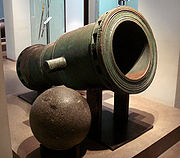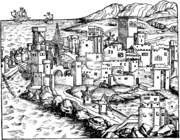.gif)
Siege of Rhodes (1480)
Encyclopedia
In 1480 the small Knights Hospitaller
garrison of Rhodes
withstood an attack of the Ottoman Empire
.
(located between Rhodes and another island, Kos
) was evacuated to Rhodes because they were susceptible to attacks from the Ottoman Empire. In 1475, the island of Chalki
(6 km west of Rhodes, smallest inhabited island of the Dodecanese
) was also evacuated to Rhodes for the same reason.
or Mesih Pasha. The Knights Hospitaller
garrison was led by Grand Master
Pierre d'Aubusson
. The Knights were reinforced from France by 500 knights and 2,000 soldiers under d'Aubusson's brother Antoine.
The Ottomans first strategic goal was to capture the Tower of St Nicholas, which was the knights key-point in the defence of the two harbours: the commercial, Mandraki, and the one to the east bay of Akandia. The Turkish artillery kept up an unbroken bombardment and on 9 June the infantry made a series of attacks. Grand Master d'Aubusson himself sped to the aid of the garrison and after a fierce struggle the enemy was repelled.
Shortly after came a second attack on the tower, this time on the eastern sector of the wall towards the bay of Akandia, which was the battle station of the "tongue" of Italy and was quite weak. During the bombardment from the Turkish artillery, the Knights and the people meanwhile dug a new moat on the inside of the wall at this point and constructed a new internal fortification. Once again the Knights reacted valiantly and decisively and after a bitter battle with many casualties on both sides, the danger was once more averted.
The last act of the drama was played out in the Jewish quarter of the city. At dawn on 27 July the Turks launched a vigorous offensive and their vanguard of around 2,500 janissaries managed to take the tower of Italy and enter the city. A frenzied struggle ensued. The grand master, wounded in five places, directed the battle and fought with lance in hand. After three hours of fighting the enemy were decimated and the exhausted survivors began to withdraw. The Knights´ counter-attack caused the Turks to beat a disorderly retreat, dragging along with them the Grand Vizier and commander-in-chief. The Hospitallers reached as far as his tent and took, along with other booty, the holy standard of Islam. On that day between three and four thousand Turks were slain.
On August 17, 1480, the Ottoman fleet gave up their attempt to capture Rhodes and sailed to try and capture Otranto.


Knights Hospitaller
The Sovereign Military Hospitaller Order of Saint John of Jerusalem of Rhodes and of Malta , also known as the Sovereign Military Order of Malta , Order of Malta or Knights of Malta, is a Roman Catholic lay religious order, traditionally of military, chivalrous, noble nature. It is the world's...
garrison of Rhodes
Rhodes
Rhodes is an island in Greece, located in the eastern Aegean Sea. It is the largest of the Dodecanese islands in terms of both land area and population, with a population of 117,007, and also the island group's historical capital. Administratively the island forms a separate municipality within...
withstood an attack of the Ottoman Empire
Ottoman Empire
The Ottoman EmpireIt was usually referred to as the "Ottoman Empire", the "Turkish Empire", the "Ottoman Caliphate" or more commonly "Turkey" by its contemporaries...
.
Preparation
In 1470, the island of TilosTilos
Tílos is a small Greek island and municipality located in the Aegean Sea. It is part of the Dodecanese group of islands, and lies midway between Kos and Rhodes. It has a population of 533 inhabitants . Along with the uninhabited offshore islets of Antitilos and Gaidaros, it forms the Municipality...
(located between Rhodes and another island, Kos
Kos
Kos or Cos is a Greek island in the south Sporades group of the Dodecanese, next to the Gulf of Gökova/Cos. It measures by , and is from the coast of Bodrum, Turkey and the ancient region of Caria. Administratively the island forms a separate municipality within the Kos peripheral unit, which is...
) was evacuated to Rhodes because they were susceptible to attacks from the Ottoman Empire. In 1475, the island of Chalki
Chalki
Halki is a Greek island and municipality in the Dodecanese archipelago in the Aegean Sea, some west of Rhodes. With the area of , it is the smallest inhabited island of Dodecanese. It is part of the Rhodes peripheral unit. It has permanent population of 330 , concentrated in the only village...
(6 km west of Rhodes, smallest inhabited island of the Dodecanese
Dodecanese
The Dodecanese are a group of 12 larger plus 150 smaller Greek islands in the Aegean Sea, of which 26 are inhabited. Τhis island group generally defines the eastern limit of the Sea of Crete. They belong to the Southern Sporades island group...
) was also evacuated to Rhodes for the same reason.
Attack
On 23 May 1480 an Ottoman fleet of 160 ships appeared before Rhodes, at the gulf of Trianda, along with an army of 70,000 men under the command of Gedik Ahmed PashaGedik Ahmed Pasha
Gedik Ahmed Pasha was an Ottoman grand vizier as well as an army and navy commander during the reigns of sultans Mehmed the Conqueror and Beyazid II....
or Mesih Pasha. The Knights Hospitaller
Knights Hospitaller
The Sovereign Military Hospitaller Order of Saint John of Jerusalem of Rhodes and of Malta , also known as the Sovereign Military Order of Malta , Order of Malta or Knights of Malta, is a Roman Catholic lay religious order, traditionally of military, chivalrous, noble nature. It is the world's...
garrison was led by Grand Master
Grand Master (order)
Grand Master is the typical title of the supreme head of various orders of knighthood, including various military orders, religious orders and civil orders such as the Ancient Order of Hibernians and the Orange Order...
Pierre d'Aubusson
Pierre d'Aubusson
Pierre d'Aubusson was a Grand Master of the order of St. John of Jerusalem and a zealous opponent of the Ottoman Empire.Pierre probably joined the Knights of St...
. The Knights were reinforced from France by 500 knights and 2,000 soldiers under d'Aubusson's brother Antoine.
The Ottomans first strategic goal was to capture the Tower of St Nicholas, which was the knights key-point in the defence of the two harbours: the commercial, Mandraki, and the one to the east bay of Akandia. The Turkish artillery kept up an unbroken bombardment and on 9 June the infantry made a series of attacks. Grand Master d'Aubusson himself sped to the aid of the garrison and after a fierce struggle the enemy was repelled.
Shortly after came a second attack on the tower, this time on the eastern sector of the wall towards the bay of Akandia, which was the battle station of the "tongue" of Italy and was quite weak. During the bombardment from the Turkish artillery, the Knights and the people meanwhile dug a new moat on the inside of the wall at this point and constructed a new internal fortification. Once again the Knights reacted valiantly and decisively and after a bitter battle with many casualties on both sides, the danger was once more averted.
The last act of the drama was played out in the Jewish quarter of the city. At dawn on 27 July the Turks launched a vigorous offensive and their vanguard of around 2,500 janissaries managed to take the tower of Italy and enter the city. A frenzied struggle ensued. The grand master, wounded in five places, directed the battle and fought with lance in hand. After three hours of fighting the enemy were decimated and the exhausted survivors began to withdraw. The Knights´ counter-attack caused the Turks to beat a disorderly retreat, dragging along with them the Grand Vizier and commander-in-chief. The Hospitallers reached as far as his tent and took, along with other booty, the holy standard of Islam. On that day between three and four thousand Turks were slain.
On August 17, 1480, the Ottoman fleet gave up their attempt to capture Rhodes and sailed to try and capture Otranto.
Gallery


External links
- http://members.tripod.com/romeartlover/Rodi.html

